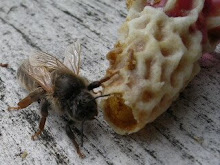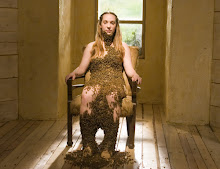Friday, October 17, 2008
Beekeeping calendar
http://www.masterbeekeeper.org/calendar/calendar_home.htm
- you may want to copy and paste onto a place on your computer, as in a bookmark, where you can refer to it now and then.
Saturday, July 19, 2008
Saturday, July 12, 2008
Foulbrood Disease
Friday, July 11, 2008
Combining Weak Hives
Swarm Season
Thursday, July 10, 2008
Mary's Requeening
Saturday, July 5, 2008
Long live the queen!
It's been a while, but I thought I'd write about my requeening today. Don and I have two hives; one is doing fine--very populous and we put our second super on today. The other, however, we have labeled our "retarded" hive. The numbers have always been fewer and it has usually been at least two weeks behind the other hive in building out comb. We never even considered adding a super for honey. Not only that, but they have been building some really strange comb: some doubles back on itself; some is wider than the frame, so it can't be built on the adjacent frame; they like to build lots of burr and bridge comb between frames and especially between top and bottom bars. The two frames that the queen cage had been between had so much shared comb by the time we were able to open the hive (remember all that COLD weather?) that we couldn't separate them without destroying brood cells, so we left them together.
So, after much agonizing, we decided to requeen. QEII (as we call her) arrived last week, and we had read that she should be laying eggs before she was introduced, so we installed her in a very small nuc of three frames of brood and honey taken from the other hives. We fed them syrup since most of the bees weren't old enough to forage and they needed to tend the brood that was hatching. They took a few days to release the queen from her cage, and she took a few more days to begin laying, but we finally saw eggs on Thursday.
That meant that we'd have to find the old queen and kill her. I was certain that the queen would be hiding in the middle of the double-framed brood comb, but we were lucky and found her running around on the second brood frame we looked at. I had to pull her off the frame with two hive tools (used like tongs) and dropped her on the ground and smooshed her with my hive tool. It was very traumatic...
Today, we moved the nuc hive into the position where the old hive had been. We disassembled the old hive and put more brood frames around the nuc frames plus some honey on the sides. Then we took the remaining frames and filled a second hive body with brood frames in the middle and whatever frames we had with honey or any comb built out on the sides. We put this second hive body on top of the nuc's hive body and then added a super baited with one frame of honey from our strong hive.
After thoroughly disturbing this hive (not to mention the poor nuc bees who'd been out foraging and didn't know where their hive went), we will leave it alone to let everyone calm down and get back to work. In a week or so, we'll check to verify that the queen has been accepted by the hive and that she is continuing to lay eggs.
Hopefully, QEII is a better queen that lays more eggs and has productive offspring with more honey storage capacity and typical comb-building genes. Then I might feel that all this drama was worthwhile and my murderous act can be justified. Maybe it's a good thing that it's so hard to deliberately do harm to another. I'm not sure I want to be able to kill any of my bees without feeling some level of regret.
Bee Mary
Tuesday, June 24, 2008
Meg's Beemergency
June 22, 2008, about 11:45. Happened to walk outside behind the barn for something and heard this very LOUD buzzing noise. Walked over to look towards the hive and saw a swirling tornado of bees circling about 20’ above the hive. Ran for the phone to call Dave: “I think I have a swarm happening! What do I do?” He was so excited for me… Told me to keep my eyes on the bees to see where they settled, at which time I’d have anywhere from an hour or so to maybe a couple of days before they took off. “Get a hive box w/foundations under wherever they settled, then shake the branch and make them drop into the box. They’ll either stay in the hive or not.” OK – I’ve got a box, but no frames put together. Told the kids, “We have a BEE-MERGENCY!” They expertly (for 6-year-olds) glued the sides & helped me assemble the frames. I hammered like crazy to get everything put together. All I had frames for was a super, so that’s what the swarm got. Ran back out to this tree to get ready, realized the branch was a little too high to reach. Ran back into the house for a stool. Ran back a couple minutes later to find…
Thursday, June 19, 2008
Swarms!
Tuesday, June 17, 2008
Busy bees
Monday, June 16, 2008
Swarm season
Dwight Filer caught a swarm. Anyone else?
Sunday, June 8, 2008
Class?
Sunday, May 25, 2008
Y'all get "A's"
Saturday, April 26, 2008
Warmer weather - time to check bees
All the new hives looked prosperous, with new cells drawn on the plastic sheets. I have seen the light: I love the plastic foundation sheets. The bees go right to work on them. They save a lot of time futzing around stringing wire and embedding pure wax foundation.
Today I'll remove the restrictions at the openings of my hives.
I look forward to reading your comments - I'd like to hear of your experiences of looking into your hives.
Monday, April 21, 2008
Cold Weather
Sunday, April 20, 2008
Cold Weather
Most likely, the bees don't have much drawn comb to store syrup in; they will starve if they have nothing coming in.
Thursday, April 17, 2008
So how did it go??
We can learn from each other's experiences. Let's hear yours! Please take a few minutes to COMMENT on the thread below.
Wednesday, April 16, 2008
Eat, drink, and Bee Mary
My name is Mary McIvor and Dave has asked that I make an occasional post as one of the newbies to beekeeping. I am so excited the bees are coming tomorrow--I feel like an expectant mother!
I have so many questions and I also have concerns about how to tell how my hives are doing. My idea is that we share information about what we are observing with our new hives and discuss what we find. Maybe this way we can tell if we are doing okay by our bees. Dave and Craig, feel free to let us know if you notice anything in our posts that concerns you or, even better, that you find promising!
The second benefit I see is that it might encourage us to keep better hive records. Let's wait until after the next weekend to give everyone a chance to watch your bees for a week or so, then you can comment on this post.
This week's request is that you give us some feedback about how much sugar water your bees are consuming.
- Are your hives feeding at the same rate?
- It would be helpful if you could estimate how many quarts per week, so our units are the same.
- After a few weeks, it might help us determine when the bees have discovered a nectar flow, as consumption of sugar water should decline.
- If you can also give your general area, we may even be able to track differences between hives in various parts of the Methow.
MM
Sunday, April 13, 2008
Note from Craig to Dave
I've been puzzling about why it seems that feral hives that are
established, say in the side of a house, a tree trunk, etc. seem to
have a better survival rate than mine. In Carlton, out of four hives
I know of, one in a log was destroyed by a bear, one in a wall was
poisoned by the owner (to my dismay), and two were removed from
houses by beekeepers.
I can't think of a single wild hive that was lost due to winter kill.
Is that your observance also?
If so, I've been wondering why.
Perhaps the process of honey removal in the fall is a major factor.
Imagine coming home in October to discover your wood pile mostly
gone, your house ransacked and holes in all the walls to let the wind
blow through. Two weeks later it is winter.
If there is anything to this, perhaps fall is the wrong time to
remove honey.
Why couldn't it wait until the spring?
The only down side I can think of is possible crystallization over the
winter. It seems like when I take honey off of dead outs in the
spring, most of the remaining capped honey is OK, only uncapped is
crystallized. However, I say this from memory and am not really sure
how true that is.
Another management technique would be to take off early honey, say in
mid-August and then leave the hives heavy over the winter. Say four
boxes high.
In the spring, remove dead outs and strip whatever seems excess for
the survivors.
What do you think?
-Craig
P.S.: Iif you think there is anything to this, you might post it on the
blog. Perhaps we could do a study with the class.
Thursday, April 3, 2008
Upcoming sessions
1. Distribution of the second half of the woodenware order: sometime late April to early May. Each hive should have two brood boxes and two supers. Most people only picked up one deep brood box and one shallow super.
2. Next field trip to Dave Sabold's apiary to examine the progress of the newly hived package bees, and answer questions about management of your own new bees. Time TBA (to be announced)






